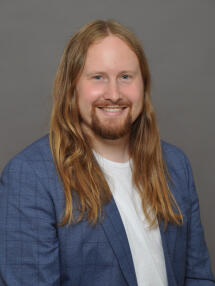Lukas Kerk
Curriculum Vitae
Academic career
since 08/2023 Research assistant at the Department of Pre- and Early Historic Archaeology of the Department of History at the University of Münster
04/2022 - 09/2022 Lectureship at the Department of Pre- and Early Historic Archaeology of the Department of History at the University of Münster since 06/2021 Member of the Münster School of Ancient Cultures (MSAC) since 02/2021 Participant in the international research cluster III "Body and Death. Concepts - Media - Practices" of the German Archaeological Institute 07/2019-06/2021 Research assistant at the Department of Pre- and Early Historic Archaeology of the Department of History at the University Münster since 11/2017
Doctoral studies in Pre- and Early History at University Münster (topic and working title: Archaeologically evident permanent body modifications) 04/2015-10/2017 Student assistant at the Department of Pre- and Early Historic Archaeology of the Department of History at University Münster 10/2014-11/2017 Master's degree in Pre- and Early History at the University Münster with the academic degree Master of Arts
(Topic of the Master's thesis: The human body as a medium: tattoos, artificial cranial deformations and tooth modifications from archaeological contexts)10/2011-09/2014 Study of 2-subject Bachelor of Archaeology-History-Landscape and History at the University Münster with the academic degree Bachelor of Arts
(Topic of the Bachelor's thesis: Tattoos on prehistoric bodies)Dissertation project
Archaeologically evident permanent body modifications
Body modifications represent a global phenomenon with enormous temporal depth. In particular, their archaeologically traceable permanent forms of expression, which appear as tattoos, skull and tooth modifications, among other things, hold great potential for knowledge regarding the human body as a socio-cultural unit and projection surface for culturally determined messages. The doctoral project will develop new theoretical and methodological perspectives on the (modified) human body in an archaeological context. Both communication-theoretical and praxeological approaches as well as neo-materialist approaches will be evaluated with regard to their applicability, further developed and linked within an integrative concept. In addition, the doctoral project is dedicated to the critically reflected consideration of interpretations of archaeologically evident body modifications. In order to develop explanatory approaches with regard to the causes of the implementation as well as the meanings and functions of archaeologically evident permanent body modifications, various forms of analogy building are made usable for the methodological approach. These are primarily archaeological-cultural-historical and cultural-anthropological comparisons. Within the doctorate, theoretical and empirical work is carried out in equal parts. The theory forms the basis for the formulation of hypotheses, which are empirically tested on the basis of the source material. Due to the special characteristics of the source material, which is largely characterized by fragmentation, isolation and a detachment from the original context both in the nature of the archaeological find and in its scientific processing and publication, a qualitative selection of archaeologically proven cases of body modifications is made. From the examination of the hypotheses and a comprehensive interpretation, further conclusions can be drawn which, in feedback to the theory, help to conceptualize the human body and its culture-specific modifications in a new way. The aim of the dissertation is to use an interdisciplinary approach to open up an area of research that is still largely new to the archaeological sciences.
Research interests- Body modifications
- Archaeology of the human body
- (Epistemological) theory in pre- and protohistoric archaeology
- Archaeological field research
www.researchgate.net/profile/Lukas-Kerk


